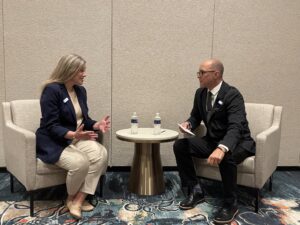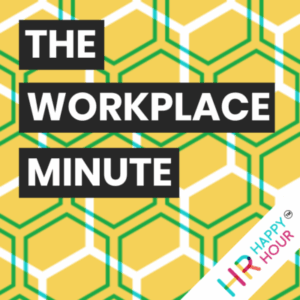Re-thinking Remote Work and the Benefits of Being in the Office
August 19, 2025
Is it possible that instead of being out-of-touch and stuck in the past, CEOs who have called for white collar workers to return to the office just might be wiser than we think? A new episode of At Work in America with guest Peter Cappelli of the Wharton School and co-author of “In Praise of the Office: The Limits to Hybrid and Remote Work” will challenge your thinking.
For over 10 years H3 HR Advisors has been a fully remote, albeit small organization. And before H3 HR, my last couple of “real” jobs were also (for me anyway), remote. So, I have been working remotely for about the last 15 years, give or take. When the pandemic hit with full force in 2020, there was not a major change or adjustment to make (workwise) for me and our team. Sure, our business slowed down, client trips and industry events were cancelled, (or taken virtual), and once we re-set, Trish created our series of “Work Break” live shows that were super fun and a welcome distraction from all the hard stuff going on in the world in 2020 – 2022 or so. But since I was so accustomed to working from home and communicating and collaborating with our team and our clients virtually, aside from the challenges in getting some office supplies now and then, work for me did not change all that fundamentally.
More broadly, however, the world of work for most white collar and office workers shifted dramatically. The data show that as of the beginning of 2020, just before the pandemic hit the US with full force, only about 7.2% of all work was being done remotely and about 15% of office work was remote. As of July 2025, those rates for remote work are about 27% of all work, and 45% for office workers. (All data from WFH Research). So, remote work has tripled, hybrid schedules have proliferated since pandemic-era lockdowns have ended, and it’s safe to say that the world of work, particularly for office workers, has fundamentally changed.
What else has changed during this five-year experiment in the design of work is how many newly remote workers came to value and even love the flexibility and freedom that remote work can offer. The benefits of remote work to employees are many and meaningful – enormous time and cost savings from not having to commute to work, ability to organize work around personal obligations and household responsibilities, less worry about clothes, shoes, hair and makeup and plenty more.
Hang on, I need to move my laundry over to the dryer and defrost a pack of Farmer’s Dog for Tillie.
Ok, I’m back.
Remote work is pretty awesome that way.
In fact, I’d be hard pressed to think of ways that remote work isn’t awesome. And I bet that is a viewpoint that is shared by many workers – both long-term, pre-pandemic remote workers like me, and the millions of workers who were disrupted into remote working by the pandemic.
But if we think about it just a bit more with a little bit of perspective, there are some ways that remote work falls short of awesome.
We (humans) just can’t form relationships with our co-workers when we are working remotely in the same way that those relationships can be built and sustained when we are in the same office, seeing, chatting, and just co-existing with each other regularly.
And it is hard to argue that much of the success we have at work is due to, at least in part, from these relationships and the ability to “tap on the shoulder” of a trusted colleague when we need help, when we have to learn something new, or when we need an empathetic person to vent to. All these things are more difficult in a remote setting.
Additionally, for new employees, especially for those who have been hired since remote (or even hybrid) work became the norm, onboarding, acculturation, and the ramp up to productivity are all much more challenging. We likely all have heard or seen examples of employees hired as long as five years ago who have never met any of their co-workers in-person.
If you are an experienced professional I encourage you to think back to your first “real” corporate job, when office work was all conducted in-person, and how you navigated onboarding, learning, and building relationships with your colleagues as well as people outside of your direct team. Can you imagine how different and perhaps impossible it would be to pull all of that off over a string of Zoom or Teams meetings?
Finally, let’s talk about culture for a moment. I will admit that I have been highly critical of many of the CEO return to office announcements that have includes language about building, maintaining, and strengthening corporate culture and how that can’t be effectively executed when most if not all employees are working remotely. But if you think about it, and are being honest about it, these CEOs are probably righter than not.
Big parts of culture are wrapped up in observation, social connections, and informal communication. Data and experience show that remote employees have fewer social relationships with their colleagues, narrower communications and learning networks, and fewer information interactions with their peers. And only the most cynical, (or disingenuous) among us would not admit that these count and they matter, and they affect culture.
I am a 100% remote worker. I would admittedly have a difficult time returning to full-time in-person work. But, if I were just starting out in my career, or joining a new company in an important job or in a leadership role, or if I had to learn a whole bunch of new things and fast, then I think I would have to put the long pants and collared shirts back on and head back to the office.
And I get why people who are being called or dragged depending on your point of view, back to in-person work are almost always not happy about it. Like I said, remote work is awesome. I baked a tin of brownies today, somewhere in between paragraph five and six. But there are tradeoffs too. And after reading In Praise of the Office, and spending an hour talking about it with Peter, I have a much more open and fairer mind about such things.
If you are in an organizational leadership role, where you are wrestling, still, with the remote/hybrid/in-person questions, I would invite you to give the episode a listen. And if you are a worker who has or will be called back to in-person work, perhaps against your own desires, I would also encourage you to tune in. There are ways to make workplaces work better for everyone – even if it is in-person. You will get plenty of ideas on how on the podcast.
Thanks to Peter Cappelli for joining us on At Work in America and opening this jaded remote worker’s mind to think a little bit more expansively.
Listen to the podcast here, and thanks to Workhuman for sponsoring the HR Happy Hour Media Network.

Author
Categories
Tags
Share
How we can help
Led by Trish Steed and Steve Boese, H3 HR Advisors harnesses over 40 years of experience to delivery HCM insights and guidance to global organizations.
H3 HR Advisory services
By leveraging technology, analytics, and our deep industry knowledge we can help you to reposition your workforce and ensure that you have the right people with the right capabilities in the right roles to positively impact the growth of your business.
HR Happy Hour Podcast Network
Created in 2009, The HR Happy Hour Show is hosted by Steve Boese and Trish Steed and is the longest continuously running internet radio show and podcast on Human Resources, HR Technology, Talent Practices, Workplace and Leadership topics.
H3 HR Speaking Services
We work closely with every client to customize your content - keynotes, webinars, research, infographics, and buyer’s guides - to inspire, educate and inform the audience enabling you to reset and realign your organization for a talent-led breakthrough.
Get in touch
Talk to us today and find out how we can help you and your organization leverage HCM technology to attract, onboard, retain and manage top talent.



